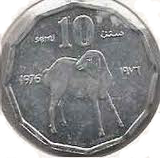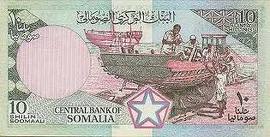|


The shilling (English), shilin (Somali, also شلن) or scellino (Italian) has been the currency of Somalia since 1962. The ISO 4217 code is SOS. It is subdivided into 100 cents (English), senti (Somali, also سنت) or centesimi (Italian).
Rival producers of Somali shillings emerged after 1991. These included the Na shilling, which failed to gain widespread acceptance, and the Balweyn I and II, which were forgeries of pre-1991 bank notes. A competition for seigniorage drove the value of the money down to about $0.04 per SoSh (1000) note, approximately the commodity cost. Consumers have refused to accept bills larger than the 1991 denominations, which has helped to stop the devaluation from spiraling further. The pre-1991 notes and the subsequent forgeries are treated as the same currency. It takes large bundles to make cash purchases. United States dollar is often used for larger transactions.
The relatively stable value of the currency in the 1990s compared to the 1980s is explained by Peter D. Little in Somalia: Economy without a State as resulting from the lack of a corrupt central government printing currency to pay for military expenditures and political cronies. Traders avoid the need to carry large amounts of Somali shillings by converting them to U.S. dollars and then wiring them to money houses in Somalia. Because identification can be easily forged, those seeking to pick up wired money are required to answer questions about their clan and kinship relations. Private remittance companies known as hawala assist in the transfer of money. One of the largest such companies, Al Barakaat, was shut down in 2001 by a U.S.-led initiative due to alleged terrorist ties; the company's communications business, with more than 40,000 subscribers, was also shut down.
With the establishment of the Transitional National Government in 2000, a group of businessmen imported about 30 billion shillings of Canadian-printed notes, sparking a collapse of the currency and wide-scale demonstrations and protests in Mogadishu. The value declined by 30 percent (to 13,000 per $1) in three months, and by the end of the 2001 the currency had fallen to about SoSh 22,000 per US dollar. Further imports of money caused additional disruption and the TNG was forced to buy up large amounts of money.
History
The shilling has been the currency of parts of Somalia since 1921, when the East African shilling was introduced to British Somaliland. In 1962 (following independence in 1960), the somalo of Italian Somaliland and the East African shilling (which were equal in value) were replaced at par by the Somali shilling. Names used for the denominations were cent, centesimo (plural: centesimi) and سنت (plurals: سنتيمات and سنتيما) together with shilling, scellino (plural: scellini) and شلن.
Starting in 1975, Somali names written in the Latin alphabet were introduced: shilin and sent, with the name for the subunit in the Arabic script reduced to سنت. The Italian names disappeared at this time and the English names only persisting on the banknotes. The Italian name scellino reappeared on some of coins in 2000. The spelling of the subunit today remains unknown as no coins of less than 1 shilling have been issued recently.
Following the breakdown of central government, the breakaway region of Somaliland has issued a currency, the Somaliland shilling. Other regional currencies as well as the U.S. dollar and euro also circulate.
For a wider history surrounding currency in the region, see The History of British Currency in the Middle East.
Coins
Initially, coins of the East African shilling and somalo circulated. In 1967, coins were issued in the name of the Somali Republic in denominations of 5, 10 and 50 cents/centesimi and 1 shilling/scellino. In 1976, when the Somali names for the denominations were introduced, coins were issued in the name of the Democratic Republic of Somalia for 5, 10 and 50 senti and 1 shiling.
Since 2000, coins in denominations of 5, 10, 25, 50 and 100 shillings have been issued in the name of the Republic of Somalia. However, this issue of coins has never been in circulation inside Somalia, and it is unclear by who it has been produced as there have been no governmental authorities anymore since 1991. The legends on these coins are written in the colonization languages English and Italian, despite the fact that the official languages of Somalia are Somali and Arabic. Most have been issued as commemorative coins such as the Chinese astrology series or as part of the F.A.O. issue.
Banknotes
In 1962, the Banca Nazionale Somala issued notes for 5, 10, 20 and 100 scellini/shillings. In 1975, the Bankiga Qaranka Soomaaliyeed (Somali National Bank) introduced notes for 5, 10, 20 and 100 shilin/shillings. These were followed in 1978 by notes of the same denominations issued by the Bankiga Dhexe Ee Soomaaliya (Central Bank of Somalia). 50 shilin/shillings notes were introduced in 1983, followed by 500 shilin/shillings in 1989 and 1000 shilin/shillings in 1990. Also in 1990 there was an attempt to reform the currency at 100 to 1, with new banknotes of 20 and 50 new shilin prepared for the redenomination .
The situation of the currency in Somalia is unknown, but as in Afghanistan before 2002, banknotes of the old issue of 5, 10, 20, 50, 100, 500 and 1000 shilling are probably being produced without honouring the serial numbers. In the south, only the 1000 shiling note remains in circulation today. All other denominations having disappeared. In the northern areas of the country, the 500 shiling note can also still be seen in circulation.
Historical exchange rates
Free market rates in southern Somalia:
* 2000 SOS/USD in June 1991
* 5000 SOS/USD in June 1993
* 13,400 SOS/USD in March 2006
* 14,406 SOS/USD in August 2006
* 15,000 SOS/USD in February 2007
* 25,000 SOS/USD in March 2008
* 35,000 SOS/USD in July 2008
* 28,250 SOS/USD in March 2009
* 33,300 SOS/USD in February 2010
The text on this page has been made available under the Creative Commons Attribution-ShareAlike License and Creative Commons Licenses
|
